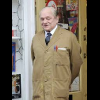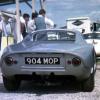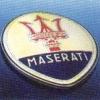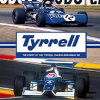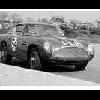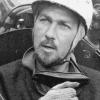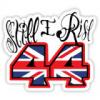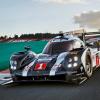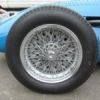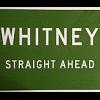It is with great sadness that we must inform Members that Tony Brooks, one of Great Britain’s greatest Grand Prix drivers, has died. He was 90 years old and had been in declining health for some time. He was one of the longest-serving BRDC Members, having first been elected as a Full Member in 1954 and subsequently becoming a Life Member.
Tony will forever be remembered as one of the pre-eminent British racing drivers of the 1950s and early ‘60s. He played a major role in some of the milestones of British motor racing. In 1955, while still a dental student at Manchester University, he won the Gran Premio di Siracusa in Sicily driving a Connaught B-type. It was his first race in a Formula 1 car in which he had never sat until 24 hours before the start of the race. He learned the circuit, which he had never previously seen, on a hired Vespa scooter while waiting for the Connaught venerable coach of a transporter to arrive.
Starting on the front row of the grid alongside the factory Maserati 250Fs of Luigi Musso and Luigi Villoresi, Tony fought wheel-to-wheel with Italy’s finest before taking the lead once and for all at around one quarter distance. Trading lap records with Luigi Musso, Tony eased away to win the two-and-a-half-hour race by over 50 seconds. On the long flight back home, he carried on revising for his dentistry finals! This was the first victory for a British car in a full-length, albeit non-championship, Grand Prix since 1924.
Less than two years later Tony, ably backed up by the late Noel Cunningham-Reid as his co-driver, gave the Aston Martin DBR1 its first major success by winning the Nurburgring 1000 Kms round of the World Sports Car Championship. Eight weeks later, having injured himself quite badly in a crash during the Le Mans 24 Hours and still feeling rather stiff and sore, Tony started the European (British) Grand Prix at Aintree in the Vanwall which he handed over to Stirling Moss and between them win a World Championship Formula 1 Grand Prix for a British car for the first time ever.
Tony’s solo victories for Vanwall came the following year when he won the Belgian Grand Prix at Spa Francorchamps, the German Grand Prix on the Nurburgring Nordschleife and the Italian Grand Prix at Monza, helping Tony Vandervell’s team to win the first World Constructors’ Championship.
Coincidentally with Stirling Moss, Tony’s father was a successful dental surgeon but, unlike Stirling whose racing career began in 500 cc Formula 3 single-seaters, Tony followed the sports car route, initially in his mother’s Healey Silverstone in 1952, principally at Goodwood which was a fair old trek in those pre-motorway days from Dukinfield near Manchester where Tony lived. He won a couple of the customary short handicap races and showed well in others.
The Silverstone was retained for a second season in Coronation Year when Tony also had the opportunity to race a Frazer Nash Le Mans Replica for Arthur Hely and his son Dudley. Pending the emergence of the lightweight, MG and Coventry-Climax engined Lotus and Coopers, the Le Mans Replica was the sports-racing car of choice under 2-litres and Tony was able to race extensively and successfully at race tracks around the British Isles through to 1955.
Tony’s driving was being noticed by motor racing cognoscenti, including Denis Jenkinson (‘Jenks’) of 'Motor Sport' magazine who had just won the Mille Miglia with Stirling Moss in a Mercedes-Benz 300SLR. ‘Jenks’ wrote: ‘I had seen him once, at a Goodwood meeting and could not fail to see an inborn talent and sense of balance and artistry that made most people look like amateurs: he took Woodcote Corner in one long controlled slide and beautifully placed for the chicane that followed, then nicked it through the chicane and made it look very easy. The driving of Brooks was so smooth and effortless and flowing, with the car balanced at the limit of adhesion.’ Informed praise indeed from someone who was never easily impressed!
Someone else who had noticed Tony’s performances in the Frazer Nash was John Wyer, Competitions Manager of Aston Martin, and another individual who was steeped in motor racing and not easily impressed. Tony was invited to a test day at Chalgrove airfield when, according to Peter Miller of Aston Martin, Tony consistently lapped more than three seconds faster over a 2-minute lap than the team’s regular drivers. Tony’s first race with Aston Martin soon followed; it was the 1955 Le Mans 24 Hours with John Riseley-Prichard as co-driver. The latter raced a Formula 2 Connaught A-type but having witnessed Tony’s talents at first hand at Le Mans, had no hesitation in offering him the opportunity of some races in the major British events. A series of impressive results with the 2-litre car against 2.5 litre F1 cars laid the foundation for the invitation to drive in the F1 Connaught at Siracusa.
By the beginning of 1956 Tony had come to be recognised, together with Stirling Moss, Mike Hawthorn and Peter Collins, as an outstanding driver. As Stirling committed to Maserati and Peter to Ferrari for 1956, Mike opted for BRM, and Tony chose to follow suit. It was a bad decision. Second place in the Aintree 200 to Stirling Moss’s privately-run Maserati 250F may look good on paper but by the end of the race Tony had been lapped and the car had long since run out of brakes. After assorted car problems resulted in failure to start the Monaco Grand Prix, disaster struck during the British Grand Prix at Silverstone when, approaching Abbey Curve, the throttle stuck open, causing the wretched car to crash heavily, Tony being thrown out before, to quote Tony ‘It did the only decent thing and set itself on fire’.
Tony sustained a broken jaw, chipped ankle, and various abrasions. Neither Mike nor Tony had any further interest in driving for BRM in 1956. For Tony the year ended on an encouraging note with victory for Aston Martin in a DB3S at Goodwood, in Rob Walker’s Mercedes-Benz 300SL at Oulton Park and in a Formula 2 race at Brands Hatch in Rob’s Cooper-Climax T41.
For 1957 Tony signed up with Vanwall as team mate to Stirling Moss while continuing with Aston Martin for sports car racing and with Rob Walker for Formula 2. In addition to the Nurburgring 1000 Ks victory already mentioned, Tony won two major sports car races at Spa-Francorchamps – the Spa Grand Prix and the Belgian Sports Car Grand Prix – but crashed in the Le Mans 24 Hours.
In Formula 1, in addition to the historic victory with Stirling Moss at Aintree with the Vanwall, Tony was second only to Juan Manuel Fangio’s Maserati 250F in the Monaco Grand Prix. In those days the Monaco Grand Prix lasted for 100 laps and required some 25 gear changes per lap. Early in the race, Tony’s clutch failed, causing gear-changing to be somewhat problematic. By the end, his left hand resembled a piece of raw steak.
Tony remained with Vanwall as Stirling’s team mate in 1958, with Stuart Lewis-Evans, who had joined the team partway through 1957, as third driver. Tony’s first solo World Championship victory came at one of his favourite circuits the ‘old’ Spa-Francorchamps in the Belgian Grand Prix, but it was touch and go as his Vanwall’s gearbox almost seized solid at the final corner – in those days the La Source hairpin. Further victories followed at the Nurburgring and Monza which brought Tony third place in the World Championship behind Mike Hawthorn and Stirling Moss. Together with Stirling, Tony won the half-points final round of the World Sports Car Championship - the RAC Tourist Trophy at Goodwood in an Aston Martin DBR1.
For various reasons, principally the death of Vanwall team driver Stuart Lewis-Evans from burns sustained in a fiery crash in the Moroccan Grand Prix, Tony Vandervell withdrew from fulltime participation in the Formula 1 World Championship in 1959 so Tony was snapped up by Enzo Ferrari to drive one of the potent Dino 246s in Formula 1 and a 250 Testa Rossa in sports car races, the latter not to include the Le Mans 24 Hours, a race with which Tony had become disenchanted.
His team mates would include the fiery French driver Jean Behra, Phil Hill, Cliff Allison and, from the French Grand Prix onwards, the very impressive Dan Gurney. On a scorchingly hot day at Reims, Tony won the French Grand Prix and a few weeks later prevailed in the German Grand Prix at the AVUS autobahn track in West Berlin.
A strike at Ferrari meant that the Scuderia was prevented from contesting the British Grand Prix at Aintree where ‘Jeannot’ and Tony had finished first and second (Tony with a smaller-capacity engine) in the Aintree 200 at the start of the season.
The revised Vanwall which Tony was able to drive instead (of his Ferraris), proved to be a major disappointment. Going into the final round of the World Championship – the first United States Grand Prix at Sebring – Tony had more than an outside chance of winning the title against opposition from Cooper-Climax drivers Stirling Moss and Jack Brabham. After being deprived of his front row grid position by Harry Schell’s shenanigans and being rammed on the opening lap by his impetuous team mate ‘Taffy’ von Trips which caused Tony to visit the pits to check for any damage, he pressed on to such good effect that he climbed back to third place after Stirling had retired early on and Jack had run out of fuel on the last lap. Although Sebring was not a Ferrari circuit, it is reasonable to suppose that Tony would have won the race and the World Championship had he not been delayed by the pit stop.
By then Tony and his wife Pina had started a family and had also opened a garage business, having concluded that a career in dentistry was incompatible with a career in front-line motor racing. Another year with Ferrari would have been possible but his other commitments meant that Tony felt that his personal interests would be better served by driving for a team nearer home. Tony Vandervell wanted to keep his team active, but it soon became apparent that he could not offer Tony a full season of racing in 1960. Of the limited options available, Tony chose the British Racing Partnership/Yeoman Credit team of Cooper-Climax T51s, new cars but a year out of date. For someone who had come so close to being World Champion, it was a hugely disappointing season with a fourth (Monaco) and two fifth places (Great Britain and Portugal) the only points-scoring results.
The decision to return to BRM for 1961, the first year of the 1500 cc Formula 1, seemed to be the right one at the time. His contract gave Tony equal status with team mate Graham Hill but the reality was rather different in the political minefield that was BRM. Despite the way he was treated, Tony gave the team its best results of the year with third place in the US Grand Prix at Watkins Glen and fastest lap in the British Grand Prix at Aintree. However, the smaller cars did not really appeal to Tony who for example now discovered that the challenge of Spa-Francorchamps was reduced to a nearly flat-out lap apart from La Source hairpin. He decided to retire, only to watch from the sidelines as Graham Hill and BRM won the drivers’ and constructors’ titles in 1962.
In retirement from driving Tony never lost his interest in Formula 1 while growing his motor business in Woking, initially as main dealers for Fiat and Lancia and subsequently for Ford. During his racing career he had regularly contributed insightful race reports to 'The Observer' with which he continued whilst also adding equally perceptive television commentary for a while. He was often to be encountered participating in Vanwall, Ferrari and Aston Martin retrospective events, always willing to talk about his era of Formula 1 or about the contemporary scene in his unassuming but forthright and meticulous manner. i
When Tony left Scuderia Ferrari at the end of 1959, Il Commendatore described him as ‘a marvellous man….a fast driver who enjoyed the fast circuits. He was an honest man. But maybe too much sometimes towards others…..a gentleman who I appreciated a lot as a man, and especially as a driver’. For Dan Gurney Tony had ‘earned the title of the Ferrari team leader. He was quietly the best, the fastest, the nicest and most polite and a great fighter on the race tracks’. Stirling Moss once said that, if he had been able to have his own Formula 1 team, the two drivers he would have wanted to drive for him would have been Tony Brooks and Jim Clark.
Most people reading this will not have seen Tony Brooks in a race. As a classical stylist, relaxed behind the wheel with arms outstretched, displaying an innate sense of balance, he was up there with Stirling and Jimmy. His autobiography, published in 2012 and all his own work, is fittingly entitled Poetry in Motion; it is now out of print but well worth tracking down. The dust jacket is red and depicts Tony at the peak of his powers in the Ferrari Dino 246.
Tony will be very much missed. To his delightful wife Pina and their five children Caroline, David, Michele, Julia and Stephanie and to his many friends and admirers, the BRDC offers its most profound condolences at the loss of a much-loved husband and father and one of the finest Grand Prix drivers of all time.
DCN
![]()












